Shocking Technology Addiction Statistics 2023 – Internet, Smartphone, Social Media and Gaming
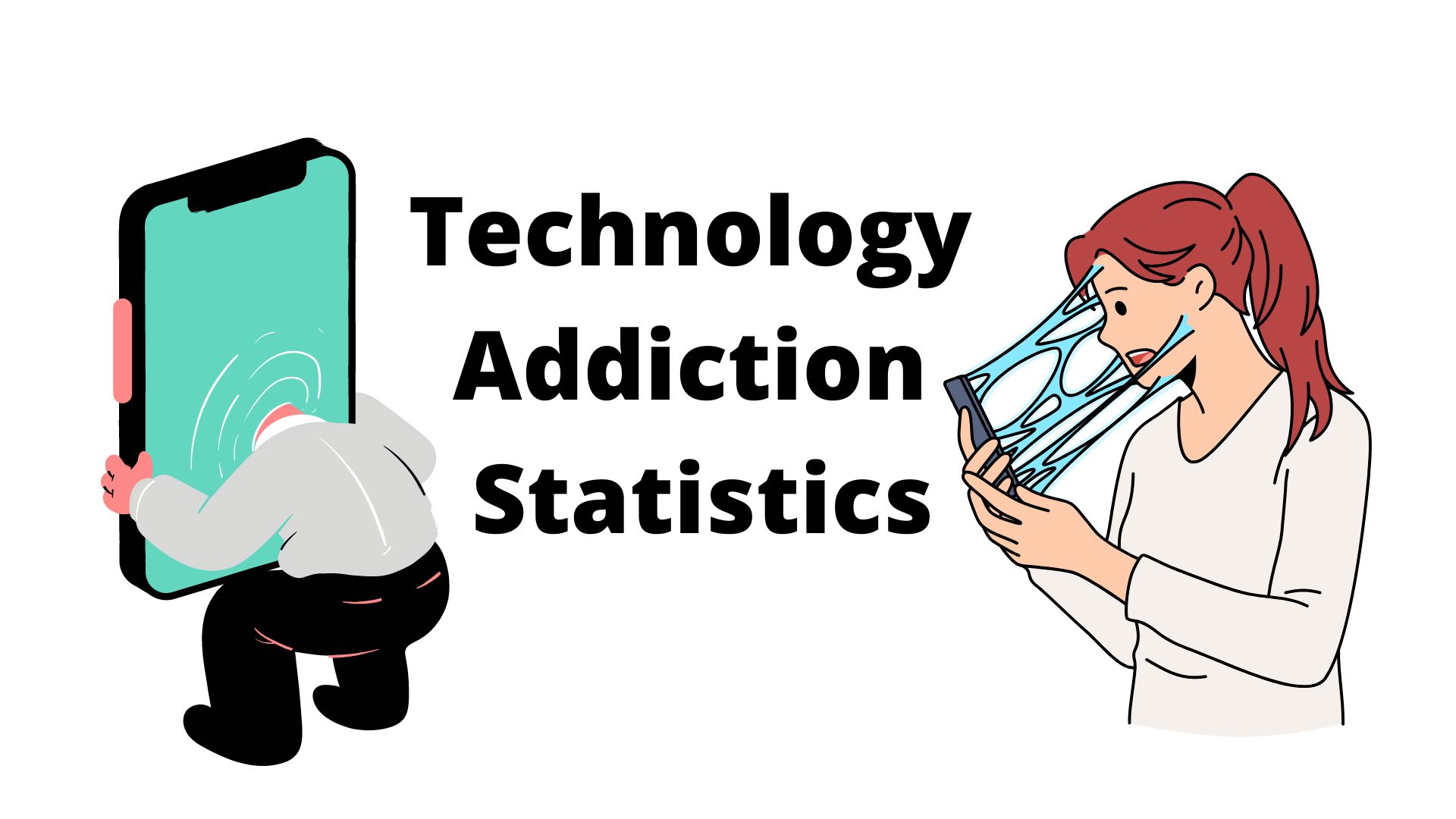
Page Contents
- Important Signs of Technology Addiction
- Smartphone Usage Statistics
- Teens Addicted to Smartphones
- Technology Addiction Statistics by Time Spent in Front of the Screen
- Technology Addition Statistics by Risk of Internet Addiction by Age
- Smartphones are Serious Distractions Statistics
- The Dangers Of Smartphone Addiction Statistics
- Social Media Addiction Facts
- Technology Addiction Statistics by Rate of Depression Using Social Media
- Social Media Platforms
- Video Game Addiction Statistics
Technology Addiction Statistics: Although technology addiction can be dismissed as an overreaction in light of our dependence on electronic devices today, many cases have been shown to have serious consequences. Actually, psychiatrists have added “internet addiction” to their list of mental disorders. In the United States, there was also a treatment facility for this type of addiction.
Over 100 technology addiction statistics have been compiled. They are centered around the three most popular platforms: smartphones, social media, and video games. We also provide information on the harmful effects of each platform. You will be able to identify the various types of technology addiction and how you can deal with them.
Important Signs of Technology Addiction
- Hiding or lying about the usage of digital devices from family or friends for feeling guilty or shameful.
- Experiencing mental health issues such as anxiety, stress, depression, or irritability at the expense of technological use.
- Using digital devices to feel energetic or happy, or to gain pleasure.
- Using devices for longer periods with increased frequency.
- Losing interest in social or leisure activities which you used to enjoy a lot.
- Continue the use of digital devices even after knowing the consequences.
- Experiencing craving to use technological devices.
- Usage of such devices while driving a car, walking on the road, etc.
Smartphone Usage Statistics
- Smartphone addiction is the most widespread type of technology addiction.
- These statistics show that smartphones are carried almost everywhere people go, even in situations that do not require remote communication. There are many apps to suit any activity.
- This is why mobile phones have embraced almost all aspects of daily life.
- Additionally, it appeals to all ages and has long been one of the most popular platforms for entertainment.
- Users can also carry the device around with them in their pockets and bags, giving it an advantage over tablets and laptops.
- The high usage of smartphones will not slow down as phone companies release new versions every year.
- Average smartphone users touch their phone 2,617 times per day. This does not include the time spent locking the phone.
- Heavy users touch their devices an average of 5,427 times per day.
- A smartphone user checks their phone on average 63 times per day.
- 82% of smartphone owners check their phones within an hour before going to bed. 35% do it within 5 minutes.
- 40% of adult users check their smartphones within five minutes after waking up.
- Users spend an average of 2 hours and 51 minutes per day on their phones.
- When tablets are added, the average time is 4 hours and 33 mins daily.
- 57% of American users said that their screen time has increased by more than an hour since the coronavirus lockdown.
- 71% of mobile phone users are asleep with their phones next to them.
- One-third of mobile phone owners would prefer to give up sex over their phones.
- In terms of sex, 20% (18-34) of phone owners admit to using their phones during intercourse. One in ten adults also admits to using their phones while having sex.
- 33% of adult smartphone users are on romantic dates with their phones.
- 35% of smartphone users reported that they used their phones while at the cinema.
- 12 percent of smartphone users feel their phones are preventing them from having a romantic relationship.
- 31% of adult smartphone users never turn off their phones.
- Users unlock their phones 150 times per day.
- An average person spends 8 hours and 41 seconds more each day in front of their electronic devices than they do sleeping.
- 58% of smartphone owners will check their phones at a minimum once an hour.
- One in three people checks their phones before midnight.
- An average user checks his smartphone every 12 minutes. Users below 21 years old have a shorter check-in time of 8.6 minutes.
- 6 percent of internet users will only use their smartphones to surf the net by 2025.
- 72% of users won't move further than five feet from their devices.
- 58% of mobile users attempted to limit their phone use, but only 41% believed they succeeded.
- Adults in the United States spend approximately 3 hours and 43 seconds in front of their phones. This is slightly more than the time they spend in front of the TV.
- Smartphone users are far more common than those with toilets.
- 75% of Americans use their smartphones to go to the bathroom.
- Unfortunately, 19% end up dropping their phones in the bowl.
- 50% of smartphone owners feel anxious when they leave their phones at home.
- 26 billion SMS messages per day are sent in the US.
- Smartphones are the last thing people check before they go to bed.
- Brazil, China, and the United States are the top 10 countries for smartphone use.
- Nearly 40% of smartphone users admit that they use their phones too often. This rate is even higher among 18-34-year-olds, at 64%
- The world has 5.19 billion users of mobile phones.
Teens Addicted to Smartphones
- Young people often enjoy going out with their friends, attending fun parties, and visiting beautiful locations.
- These themes are often found on young people's social media accounts. Smartphones are now part of our daily lives. This increases the risk of developing addictions.
- Teenagers often use smartphones because they fear missing out, which leads to a high usage rate.
- Common Sense Media's 2016 study found that half of American teens believe they are addicted to their smartphones. 59% of their parents are in agreement.
- 78% of teens check their phones at least once an hour.
- 72% feel that teens should immediately respond to text messages and instant messages.
- A third of American teens and parents disagree about their smartphone use.
- Screen Education's Teen Smartphone Addiction National Survey 2018 found that 71% of teens recognize apps as addictive.
- 33% of teens prefer to communicate with their friends online over meeting up in person.
- 69% of teens prefer to meet up with close friends than chat online, which is quite interesting.
- 41% feel overwhelmed by the amount of notifications teens receive each day.
- Teens spend 80% of their time on smartphones in bed before falling asleep.
- 70% of teens spend their time using 3-5 apps on smartphones.
- 49% believe their attention spans have been reduced by cellphone use.
- The highest percentage of people who are constantly online are living in Urban areas (37%), followed by Suburban (30%) and Rural (23%).
- According to Technology Addiction Statistics by demographics, the percentage of addiction is found in people with income more than $75,000 resulting in 40%.
Technology Addiction Statistics by Time Spent in Front of the Screen
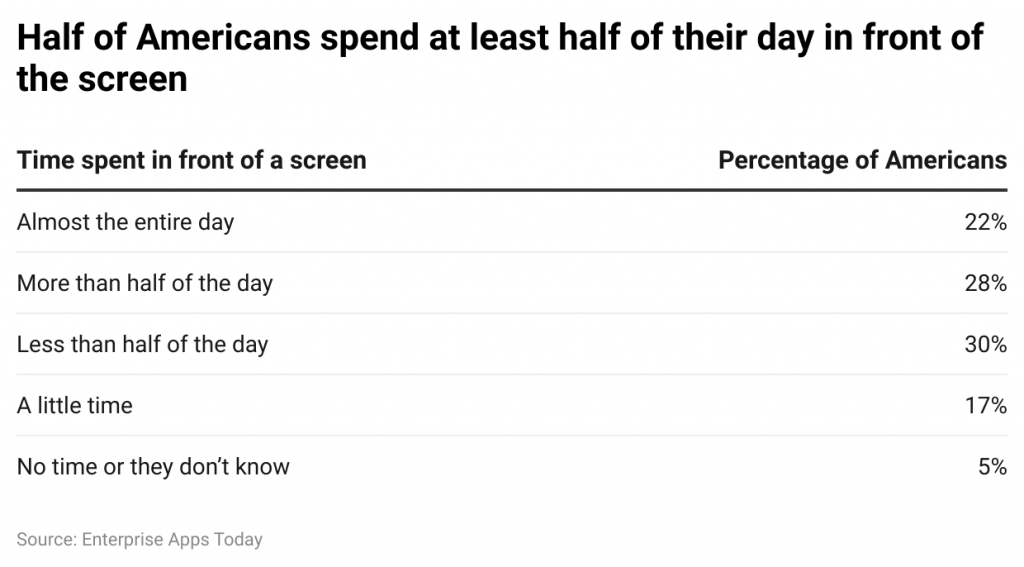 (Source: headphonesaddict.com)
(Source: headphonesaddict.com)
According to Technology Addition Statistics, 30% of Americans spend time on screen for less than half of the day, while 28% do it more than half of the day. Consumers with comparatively more addiction are found using it for almost the entire day.
Technology Addition Statistics by Risk of Internet Addiction by Age
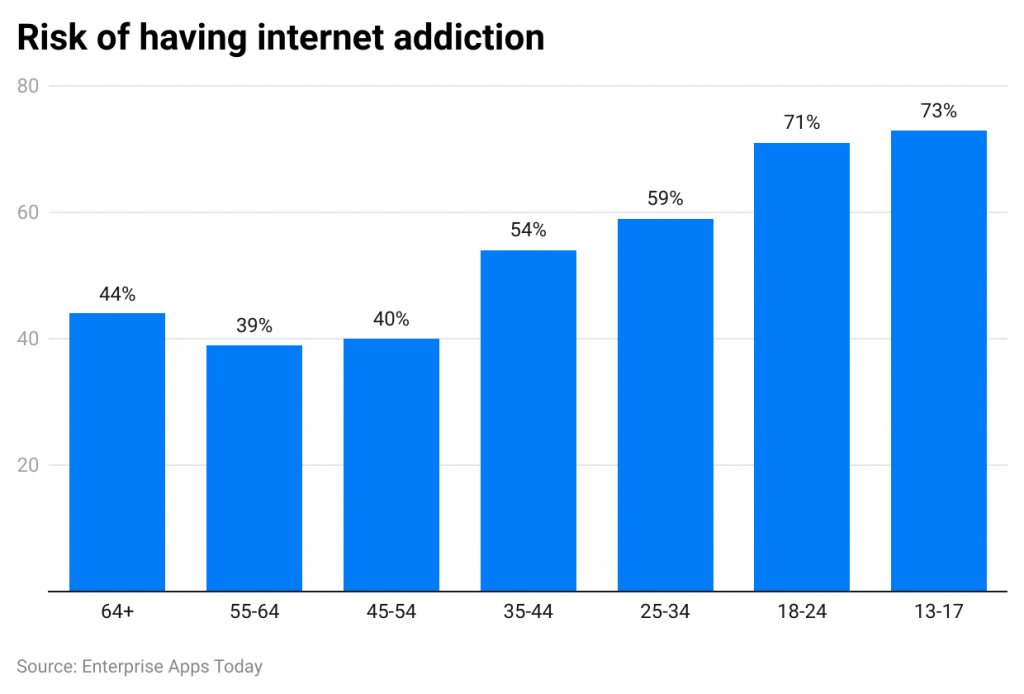 (Source: headphonesaddict.com)
(Source: headphonesaddict.com)
According to some research, the highest risk of having Internet addiction is observed for children aged between 13 to 17 years. Till 44 years, there’s a persistent high risk. The rate of risk decreases till the age of 64 years, and it might increase for people aged 64 years and above.
Smartphones are Serious Distractions Statistics
- It takes up a large portion of a person's day to use a cell phone, which can limit the time that one would spend on other activities.
- The device's pull at attention can be a major distraction at school and work.
- This could impact one's professional or academic performance. With millennials starting to assume leadership roles in businesses, they could have used the time that they waste on their phones to improve business initiatives.
- 84% check their phones at work for personal information.
- 86% of smartphone users check their phones when they are talking to their family or friends.
- 52% of teens meet up with their friends and spend time on their phones, despite them being close.
- Teens are on average glued to their smartphones nine times an hour, even while they're doing homework.
- 35% of teens consider it rude to watch videos, play games, or use social media while in class.
- 30% of teens end up not doing the things they want to because their phones keep them distracted. 35% of teens couldn't do what they needed for the same reason.
- 72% of teens watch their peers play games and videos while in class.
- 36% admit to spending two to three hours per day at work fixing up their smartphones for personal use.
- 70% of workers report feeling distracted by their smartphones while working. The rate would increase to 74% if it were down to only millennials and Generation Z-ers.
The Dangers Of Smartphone Addiction Statistics
- While smartphones can be distracting at work, they can also pose a danger while driving or crossing the roads.
- Distracted driving leads to road accidents that are the number one cause of death worldwide.
- An accident can easily be caused by the minutes you spend answering text messages and calls. It only takes seconds to get in a collision at high speed.
- 41 states have banned texting while driving for the reasons mentioned above. However, texting while driving is not prohibited in 41 states of the US.
- Zendrive has found that 88% (or more) of drivers use their smartphones on their trips, according to a survey.
- The National Highway Traffic Safety Administration lists cell phone use as the top distraction while driving.
- According to the National Safety Council Estimates, cell phones caused 1.1 million car crashes.
- Mobile phone usage is the cause of 26% of car accidents.
- Incredibly, only 5% are related to accidents involving smartphones if the driver doesn't use social media for texting or messages.
- Distracted driving was responsible for the death of 2,841 people across the US in 2018.
- Drivers who use their cell phones while driving are four times more likely to be in an auto accident than those who use them.
- Drivers average 3.5 minutes per week on their smartphones while driving. A two-second distraction can increase the chances of a collision by 20%.
- 56% say their parents have used their phones while driving. 51% of teenagers have witnessed this happen.
- Distracted driving caused by smartphones causes 11 teenagers to die each day.
- 32% of teens text while driving.
- 52% of teens are addicted to using their phones while driving.
- 71% are more likely for teens to use their phones five hours a day than those who only use one hour per day.
- 51% of teenagers who spend five hours a day on their smartphones are less likely to get enough sleep than those who only use their phones for an hour each day.
- 90% of teachers surveyed admitted that mobile phone usage has resulted in an increase in students with mental health concerns.
- The body's ability to produce melatonin is reduced by the light emitted from phone screens, which can cause trouble sleeping.
- Research suggests that people experience withdrawal symptoms when they are unable for long periods to answer their phones.
Social Media Addiction Facts
- Socializing online can have its own set of challenges, as opposed to non-virtual counterparts.
- The physical distance between the parties allows users to be bolder in their opinions, even if they are negative. Online bullying can be a problem, as it can lead to mental and emotional damage.
- The platforms can encourage illicit activities like cheating and sexual solicitations, as they are anonymous.
- Even innocent posts can have harmful consequences for other users. People who are down on their luck might feel inadequate when they see how others use social media to make themselves feel better.
- Unloved can also be felt by someone who sees friends interact with one another, even though they haven’t responded to his messages.
- When you are online, it is important that you have a positive outlook.
- The excessive use of social networks can lead to increased levels of narcissism.
- A lot of social media use can result in lower self-esteem.
- Facebook users who use Facebook frequently are more likely than others to get into conflict with each other.
- Facebook is now a leading cause of divorce.
- In the US, between 11%-43% feel sorry when their posts are only liked a few times.
- 37% of 18-24 year-olds who use social media find it difficult to log on and access their accounts.
- 21% of the same age feel restless when they cannot check messages on Facebook.
- US drivers admit to using social media while driving. This can lead to distracted driving which can cause car accidents.
- 8th graders who use social networking heavily are 27% less likely to experience depression.
Technology Addiction Statistics by Rate of Depression Using Social Media
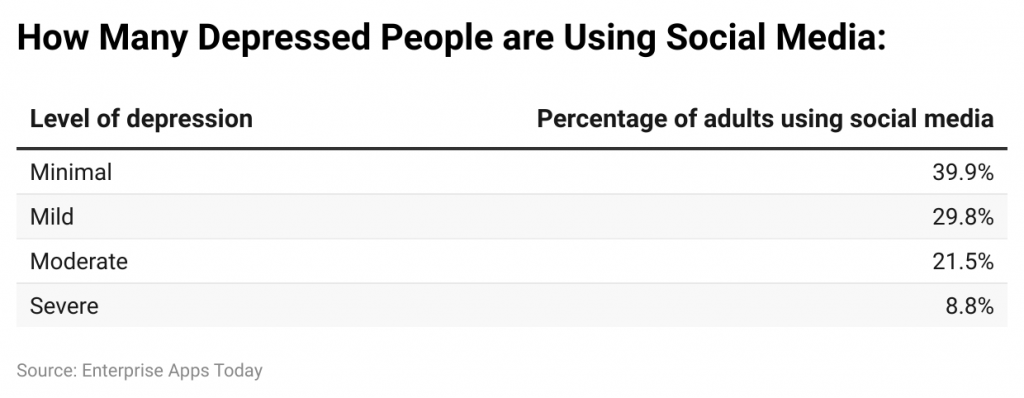 (Source: headphonesaddict.com)
(Source: headphonesaddict.com)
There are 8.8% of people with severe levels of depression caused by technology addiction, whereas 39.9% of technology users experience a minimal level of depression.
Social Media Platforms
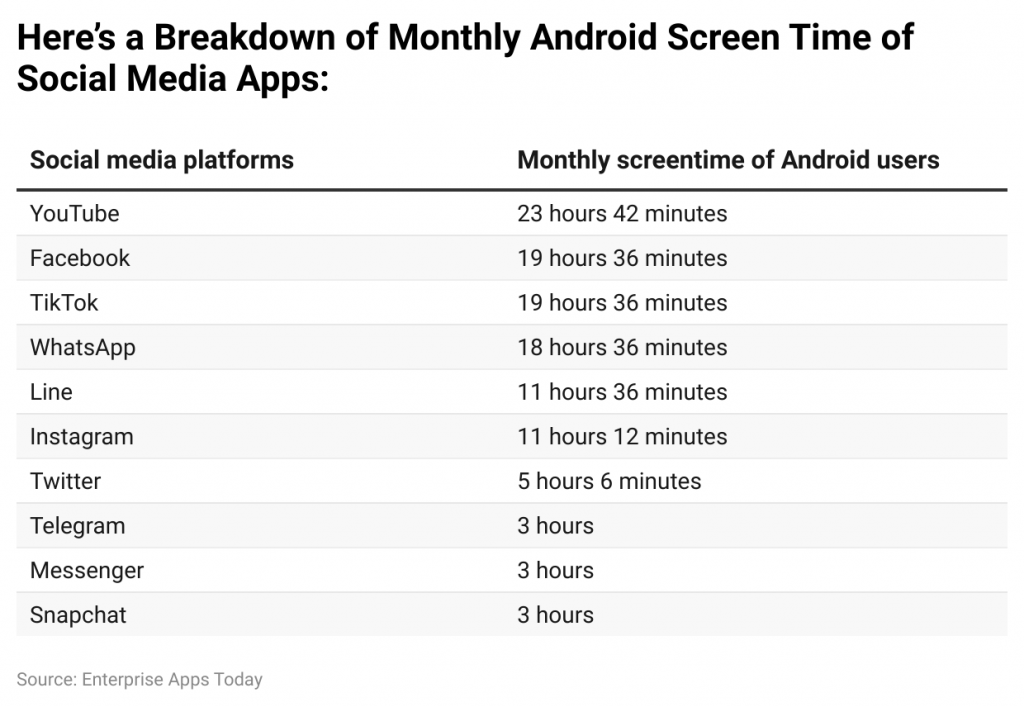 (Source: headphonesaddict.com)
(Source: headphonesaddict.com)
YouTube is the most popular social media platform among Android users by total screentime spent every month resulting in 23 hours 42 minutes, followed by Facebook 19 hours 36 minutes, and TikTok 19 hours and 36 minutes.
Video Game Addiction Statistics
- The World Health Organization officially recognizes gaming addiction as a disease.
- According to Video Game Addition Statistics, a normal gamer spends 6h 20 minutes each week playing video games while problem gamers spend 80 to 100 hours for a similar duration.
- Gamers who are dedicated to their game often abandon other hobbies or relationships to pursue the next level.
- Gaming addiction can lead you to addictive gaming experiences that can sometimes spill over into your real life.
- It is important to find a balance between work and leisure if a participant is not at the required level to take part in eSports tournaments.
- Smartphone addiction is often linked to video game addiction because mobile phones can run a huge number of gaming apps. 76% say they prefer to play video games via their mobile phones.
- 83% of teenage girls and 97% on the male side play video games.
- Gamers spend on average 7 hours, 7 minutes, per week.
- Hardcore gamers surpass that amount. Male gamers can play for up to 4 hours and 43, and females for 4 and 23 minutes each.
- 26-35-year-old gamers are the most avid gamers with an average weekly time of 8 hours and thirteen minutes. They are followed by 18-25-year-olds who play 7 hours each week and 47 minutes. Then there are 36-45 and 45-year-olds who play for 7 hours each and 46 minutes.
- Males tend to play more than their female counterparts. Males average 7 hours 53 minutes per week and females 6 hours 17 minutes.
- Players spent 2.01 hours using their mobile phones, followed closely by 1.59 hours with computers, 1.25 hours with gaming consoles, 1.04 hours with tablets, and 1.59 hours with computers.
- 47% say that their teenage boys spend too much time on video games. Only 11% share the same opinion among teenage girls.
- The only thing that makes male gamers hardcore is their ability to play. They spend an hour and 53 seconds per day looking for new games.
- Male gamers who are hardcore gamers typically own an average of 80.21 games while their female counterparts only have 64.44.
- Male gamers who are serious about gaming often buy 5.05 and females 2.67 new games.
- The world is home to 2.7 Billion gamers.
- Adolescents prefer to play video games over reading, homework, and engaging in sports and active leisure.
- On average, a video gamer spends 1 hour and 6 minutes gaming every day, which becomes 7 hours and 42 minutes per week and 30 hours and 48 minutes per month.
Leisure and Addiction are two different things. Leisure is very motivational and takes out your stress but addiction builds on your stress. So guys please understand your priorities and choose what will help you to drive your capacity more but not addict you to be more handicapped to the technology.
FAQ.
Technology is all around us and has a huge impact on our daily lives. According to stats on tech addiction, more than 220 million people have some type of internet-related addiction.
The majority of people who use technology have no problems. In fact, they can enjoy many benefits. However, a few could become addicted and experience the same consequences as those who abuse substances.
In fact, technology addiction statistics reveal that 50% of teens feel that they are addicted to their smartphones. And that's just the ones who admit it.
Adolescents aged 15-16 years, especially male adolescents, are the most prone to the development of Internet addiction, whereas adolescents aged 11-12 years show the lowest level of Internet addiction.
According to estimates, internet addiction affects 6% of the population worldwide.
Their scrolling habits could be influenced by addiction. The latest statistics are from the report: 84% of teens use social networking sites, and 62% of teens use them every day. Teens spend an average of 1 hour and 27 minutes per day scrolling through social media. This is 17 minutes more than in 2019.

Barry is a lover of everything technology. Figuring out how the software works and creating content to shed more light on the value it offers users is his favorite pastime. When not evaluating apps or programs, he's busy trying out new healthy recipes, doing yoga, meditating, or taking nature walks with his little one.